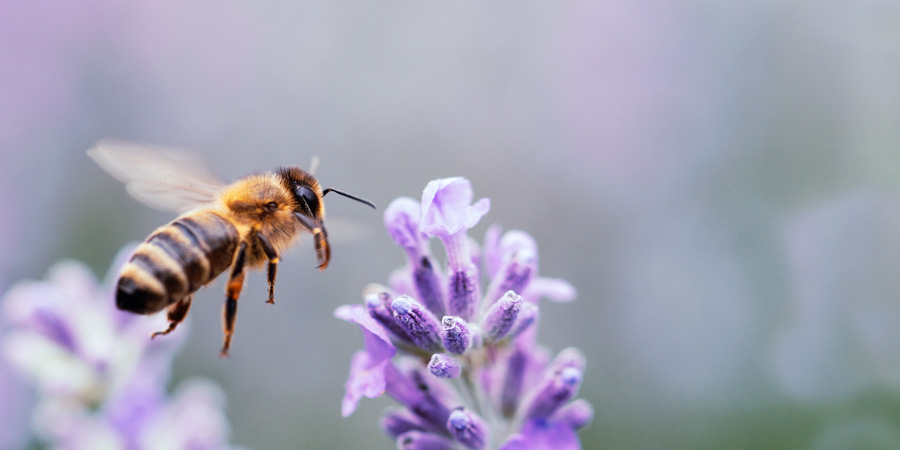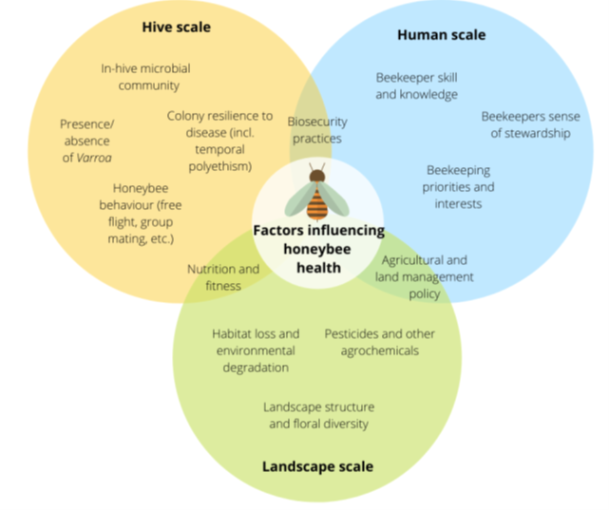One health, an effective approach to promote biodiversity – the case of honeybee’s declines

Pollinators are a key component of global biodiversity, providing vital ecosystem services to crops and wild plants, yet biodiversity of insects is threatened worldwide (Sánchez-Bayo, 2019). Since the beginning of the millennium, there is clear evidence of recent declines in both wild and domesticated pollinators, in particular honeybee populations (Apis mellifera L.) (Potts, 2010; Sánchez-Bayo, 2019). This leads in parallel to a decline in the plants that rely upon them.
Most of research on bee decline, carried out mainly by entomologists, physiologists, and ecologists, has focused on external factors like chemical pesticides, land use change, diseases, and pests (Scheper, 2013), and on internal physiological traits (i.e., host gut microbiota, immune response, or genetic variation) (Mattila, 2012; Schmid, 2008; Saltykova, 2005). Yet, veterinary sciences have an important perspective that we need to engage with. Honeybees are closely linked to human well-being, through pollination of wild and agricultural plants, and through honey production (Hanley, 2015). They are a perfect example of the need for interdisciplinary engagement for health, as their health is determined by many factors within the landscape, human society, and the hive.
Therefore, a recent review (Donkersley, 2020) explores the potential for veterinary science to address the challenge of the current bee declines with the One Health approach. This study attempts this by analyzing different factors operating at three scales (hive scale, human scale, and landscape scale). They believe these factors can, independently or in combination, shift the bee health balance.
Hive-scale factors that influence bee health
Hives are a very complex environment, with many thousands of inter-bee and inter-species interactions between human and honeybees. They contain a high diversity of invertebrates, fungi, virus and bacteria that co-exist within and on honeybees. Honeybees pose three specific management challenges to beekeepers related to their behaviour. As they are reliant on the open environment for large parts of their lives, bees interact with individuals from other colonies, and potentially transmit diseases and pests by arriving back to the wrong hive, robbing other hives for food, visiting plants previously visited by infected bees, etc. (Traver, 2011; Frey, 2014; Anderson, 2013). Thus, pest management (mainly Varroa) requires a One Health holistic and integrated approach as managing bee health involves beekeepers to be skilled observers of their colonies (Adams, 2018).
Human-scale factors relating beekeepers, scientists, farmers and all the heterogenous beekeeping community influencing bee health
As honeybee health is mainly impacted by factors within the hive, beekeepers are responsible for monitoring hive health, as well as interacting with other actors whose actions affect bees, such as farmers and bee inspectors. Beekeepers’ knowledge and practices are central to any efforts to reverse bees’ decline as their role in monitoring and ensuring honeybee health serves as a linkage between hive-based factors, and wider landscape scale factors. More interaction between scientists and beekeepers is needed, as well as a greater regard for beekeepers’ knowledge from policy makers. Indeed, policy makers rely primarily on formal scientific understanding of bee health to address pollinator decline while beekeepers’ experiential and observational knowledge are often being dismissed as anecdotal. Therefore, a One Health perspective seems essential to facilitate constructive engagement with seemingly disparate understandings of bee health, and to enable the insights of the full, heterogeneous beekeeping community, as well as bee scientists, veterinarians, and farmers. By considering bee decline within a One Health framework, the shared challenges to human, bee, and wider environmental health created by the industrial food system could be addressed (Willett, 2019).
Two major landscape-scale factors-nutrition and agricultural intensification-affecting bee health
Landscape-scale factors affect bee health primarily through two major pathways: nutrition and agricultural intensification.
Nutrition is essentially the amount of forage for bees (nectar and pollen sources) within the landscape, which is highly affected by the land use composition around pollinators. The amount, richness, and diversity of pollen that bees forage is directly linked to landscape heterogeneity and composition. Regarding their food intake, insects can adapt what they eat according to their health status, when they have a choice of diet (Lee, 2006). Further research shows that the nutritional status of honeybee populations vary consistently along with landscape type, urban and forest environments being positive for honeybee nutrition (Donkersley, 2017).
As for agricultural intensification, this factor mainly concerns the effects of pesticide use on honeybee health. While beekeepers are key stakeholders responsible for ensuring bee health and have historically provided evidence of pesticide risks to bees (Maderson, 2016; Reed, 2015), in practice, agrochemical risk and application is assessed and controlled by scientists and farmers. These actors may not be evaluating bee health in the same way as beekeepers, or may not have the same priorities in land management (Suryanarayanan, 2013; Sponsler, 2019) which show the necessity to have a One Health approach.
A One Health approach to effectively bridge these differents sectors and scale
As honeybees live in a complex social-ecological system, influenced by highly varied forms of human management, from the hive- to landscape-scale, a One Health perspective is required. This concept can effectively bridge these different sectors and scales, focusing as it does on interdisciplinary approaches to understanding health.
Honeybee health cannot be separated from the health of the environment that surrounds them (Donkersley, 2017). Honeybees can make an entire agricultural and food system dependent on their pollinating and honey-producing activities vulnerable, as they are often responsible for the decline of local wild bees (Vanbergen, 2013). The figure below summarizes the factors influencing honey bee health at different scales, and clearly illustrate with the overlap points between the different scale the need for a One Health approach to address challenges to honeybee health.

- Bee Health is influenced by hive-scale, human-scale, and landscape-scale factors.
- A One-Health approach to bee health highlights the need to incorporate landscape-scale factors alongside other factors functioning at the hive-, and the human- scale.
- Honeybee health cannot be separated from the health of the environment that surrounds them, as a single health issue for honeybees can make an entire agricultural and food system dependent on their pollinating and honey-producing activities vulnerable, and thus threaten food security.
Based on : Donkersley P, et al. A One-Health Model for Reversing Honeybee (Apis mellifera L.) Decline. Vet. Sci. 2020, 7, 119
